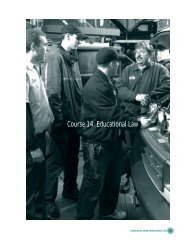Facilitating
Teaching and Facilitating Learning - Level 2 - Washington State ...
Teaching and Facilitating Learning - Level 2 - Washington State ...
- No tags were found...
Create successful ePaper yourself
Turn your PDF publications into a flip-book with our unique Google optimized e-Paper software.
○ ○ ○ ○ ○ ○ ○ ○ ○ ○ ○ ○ ○ ○ ○ ○ ○ ○ ○ ○ ○ ○ ○ ○ ○ ○ ○ ○ ○ ○ ○ ○ ○ ○ ○ ○ ○ ○ ○ ○ ○ ○ ○ ○ ○ ○ ○ ○ ○ ○ ○ ○ ○ ○ ○ ○ ○ ○ ○ ○ ○ ○ ○ ○ ○ ○ ○ ○ ○ ○ ○ ○ ○ ○ ○ ○ ○ ○ ○ ○ ○ ○<strong>Facilitating</strong> Students to Reason and Think CriticallyReprinted with permission from A Learning Facilitator’s Workbook by Jim Pollard,Spokane Falls Community CollegeAs a learning facilitator I engage learners in activities that are based on the followingpremises:First: I firmly believe that thinking should be taught in every course, to the end that learners ofhistory would be thinking historically, learners of biology would be able to think biologically.The same would be true of all subjects.Second: The elements of reasoning are basic to the way in which the mind works, when itworks well. When you find someone who is good at what they do, you will find someonewho has learned to apply the elements of reasoning to their field. Good saddle makersunderstands the logic of saddle making because they have applied the elements of reasoningto the art of saddle making. The same is true of good plumbers, designers, police officers,photographers and so on. As natural as this process may seem, I know that the purposefulrecognition of the thinking process, that is to say the elements of reasoning, will improvethinking.Third: Every individual can learn to think more effectively.Fourth: I have come to believe that the study of thinking is really the study of learning. It islearning that is basic to the human process. Thinking is a means to learning. Improving yourthinking is actually improving your ability to learn. For this to make sense you need to seelearning as being more than memorizing. Learning is figuring out, discovering, problemsolving and making sense of things, all of which is summed up in the notion of discoveringthe logic of things.I regularly emphasize critical thinking in all of the following ways:1. I see myself, not as a teacher but a facilitator of learning.Example: When asked questions I first decide rather the question is a information question, aopinion question or a thinking question. If the question is information question I suggestwhere the learner might find the answer. If the question is a matter of opinion, I encourage thelearner to seek varying points of view and move away from opinions. If the question is athinking question, I ask either a element of reasoning question or encourage the learners toapply some standard to their thinking.• I do not evaluate. I encourage the learner to self-assess. I ask questions or suggestoptions.• I assist in focusing the discussion.• When asked for direction, I try always to give three options.• I do not take ownership over a learner’s activity, project or learning. I support what thelearner is doing.• I encourage, motivate and support.I attempt to create a learning environment that could be described as productive confusion. Ifthe learner is working his/her way out of the confusion, I feel I am doing my job.2. I do not engage in any activity that doesn’t directly impact learning.Example: I do not write tests. I assist learners in writing test questions.2.18CURRICULUM GUIDE: TEACHING & FACILITATING LEARNING - LEVEL 1I




